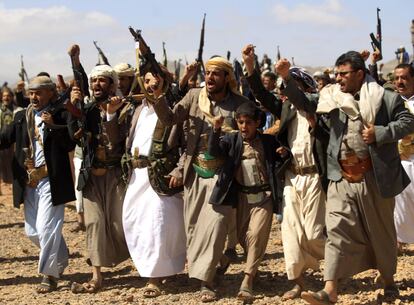The Houthis, from Yemeni militia to threat against global trade in the Red Sea
The attacks on a crucial commercial artery under the pretext of solidarity with Gaza have increased the regional weight of the fundamentalist group, which controls nearly 30% of the Arab country


The capture of a mega-ship sailing unladen towards the Suez Canal on November 19 — the Galaxy Leader, now turned into a fairground attraction where Yemenis take selfies — has since the beginning of the war in Gaza been the most spectacular action carried out by the Houthi militia, the fundamentalist group that has declared the opening of “a third front” against Israel in the Red Sea and that controls about 30% of Yemen’s territory. The hijacking of that transport ship — linked to Israeli billionaire Abraham Ungar — by a squadron of hooded men carrying Yemeni and Palestinian flags using an old helicopter was striking, but also innocuous. The only people harmed so far are the British company that owns the vessel, and the 25 unfortunate crew members who are still being held hostage on the ship. Nor have any of the 100 or so drone and missile attacks on other ships in the Red Sea that the U.S. has blamed on the Houthis resulted in any deaths or major property damage.
These “limited” attacks, says Luciano Zaccara, a professor at Qatar University’s Gulf Studies Center, have been enough, however, for this militia to demonstrate “the vulnerability of the world’s sea lanes.” The fear of new attacks in the Red Sea and the Suez Canal has “put the world economy in check” and forced Washington to announce an international mission to protect shipping in the area, after the most important shipping companies announced the suspension of the transit of their vessels through a waterway by which 10% of international trade circulates.
The strategy of the Houthis — members of what their main sponsor, Iran, describes as the “axis of resistance” to the United States and Israel, which also includes Hamas and the Lebanese Shiite militia-party Hezbollah — “can be seen as the best move to support Hamas, put pressure on Israel, and save face for not being able to do much more [to stop the war in Gaza],” says a report by the Washington-based Foreign Policy Research Institute. These attacks can also be analyzed as an attempt to increase the battered legitimacy of the militia in the eyes of its own population and on a regional scale, due to its involvement in the war in Yemen and its reactionary and repressive character. To this end, the Houthis are now presenting themselves as a champion of the Palestinian cause, which enjoys almost unanimous support among Arab populations. “Especially in Yemen,” says Leyla Hamad, a Yemeni journalist, via telephone.
Hamad considers that the group’s quest for legitimacy has ideological motives, but is aimed above all at the Houthi militia’s attempt to increase its weight as a regional actor at a time when it is negotiating a definitive peace agreement with its nemesis in the conflict that has shaken Yemen for nine years: Saudi Arabia, the other side in a war that the United Nations considers “forgotten.” Riyadh is seeking a ceasefire that would make the de facto truce it has maintained with the Houthi rebels since 2022 definitive. This would allow the Saudi regime to concentrate on its ambitious agenda of internal reforms, known as Vision 2030 and championed by Saudi strongman and crown prince, Mohammed bin Salman.
The Believing Youth
The real name of the Houthi militia is Ansar Allah (Supporters of God), although it is better known by the clan name of its first leader, Hussein Badreddin al-Houthi. Founded in the 1990s, its origin was as a religious group, the Believing Youth, which aspired to revive the branch of Shia Islam known as Zaydism, professed by a third of the more than 33 million inhabitants of Yemen, and to improve the living conditions of this minority.
The group, which took up arms in 2003 against dictator Ali Abdullah Saleh, joined peaceful protests in 2011 to force the autocrat from power. Meanwhile, they continued to arm themselves and seize territory. In 2015, the Houthis seized the capital, Sana’a, and deposed Saleh’s successor, Abdrabbuh Mansur Hadi, who ended up in exile in Saudi Arabia. A year later, Riyadh assumed the lead of an international coalition to restore Hadi to power. Saudi backing for Yemen’s internationally recognized government, coupled with Tehran’s support for the Houthis, caused the conflict to escalate into a proxy war that the two countries turned into a chessboard in their struggle for regional hegemony. At least 250,000 Yemenis were killed, 4.5 million were displaced and half of the population suffered a severe famine which the UN defined as “the worst humanitarian crisis” in the world.
The latest negotiations between the Houthis and the Saudis to put a definitive end to their armed confrontation ended without result in September. In this context, the Gaza war has offered the Yemeni rebels what Hamad describes as an opportunity to “establish themselves as a relevant regional actor, with an agenda of their own, at a time when the final peace agreement with Saudi Arabia is being negotiated.”
No international response
When Yemeni insurgent attacks began in the Red Sea, a Houthi spokesman stated that they would only target ships owned by Israelis or bound for Israeli ports. The fear of the major shipping lines is that any vessel passing through the Bab al-Mandab Strait, the gateway to the Red Sea, will be attacked. That fear has, however, turned out to be relative. On Wednesday, most of the ships owned by one of the lines that had announced its withdrawal from the Red Sea — Denmark’s Maersk, the world’s second-largest by cargo volume — were sailing back to Suez. However, as reported by Reuters, an attack on a container ship on Sunday led Maersk to interrupt shipping in the area for 48 hours.
“The Houthi attacks in the Red Sea are in reality a nuisance that has not harmed Israel,” says Fernando Carvajal, a member of the UN Group of Experts for Yemen between 2017 and 2019. The researcher maintains that the U.S. naval deployment, called Operation Prosperity Guardian, has a merely “defensive” character, aimed at showing “a commitment by Washington” without having to “attack the Houthis in Yemen,” something that is not in the interest of “Israel or the U.S., nor, above all, Saudi Arabia,” he explains by telephone from Los Angeles. Hamad agrees that the actions of the Yemeni rebels have not resulted in an “immediate” response because “all the actors, including the U.S., are aware that an open conflict in the Red Sea is not desirable.”
The Houthi militia controls a large part of Yemen’s Red Sea coast. The United Nations estimates that they have some 100,000 supporters, although not all of them are combatants. Their main supplier of training and weapons is Iran, which provides them with drones, intelligence, and “even missiles with a range of 1,200 kilometers,” notes Carvajal. Their model is Hezbollah and their motto: “Death to America, death to Israel, cursed be the Jews, victory for Islam.” However, the UN expert considers that the Houthis, rather than defending the Palestinian cause, “are served by the war” and are using this “narrative” to acquire the position of strength they seek.
An analysis by Italian researcher Eleonora Ardemagni, published by the Italian Institute for International Political Studies, agrees: “By opening a front in the Red Sea, the Houthis are exploiting the war between Hamas and Israel to divert attention from their authoritarian regime, broaden popular support, and increase their regional prestige. This allows them to reinforce pressure on Saudi Arabia for further concessions in bilateral ceasefire talks. The Houthis are banking on the fact that neither the Saudi kingdom nor the United States will react firmly against them.”
Sign up for our weekly newsletter to get more English-language news coverage from EL PAÍS USA Edition
Tu suscripción se está usando en otro dispositivo
¿Quieres añadir otro usuario a tu suscripción?
Si continúas leyendo en este dispositivo, no se podrá leer en el otro.
FlechaTu suscripción se está usando en otro dispositivo y solo puedes acceder a EL PAÍS desde un dispositivo a la vez.
Si quieres compartir tu cuenta, cambia tu suscripción a la modalidad Premium, así podrás añadir otro usuario. Cada uno accederá con su propia cuenta de email, lo que os permitirá personalizar vuestra experiencia en EL PAÍS.
¿Tienes una suscripción de empresa? Accede aquí para contratar más cuentas.
En el caso de no saber quién está usando tu cuenta, te recomendamos cambiar tu contraseña aquí.
Si decides continuar compartiendo tu cuenta, este mensaje se mostrará en tu dispositivo y en el de la otra persona que está usando tu cuenta de forma indefinida, afectando a tu experiencia de lectura. Puedes consultar aquí los términos y condiciones de la suscripción digital.
More information
Archived In
Últimas noticias
Welcome to the post-religion era: The idea of Christianity as the absolute truth has become obsolete
‘I thought you would like it’: The risky sexual practice popularized by TV shows and TikTok
The digitalization of tourism: ‘They promise experiences and gave us the worst possible one’
Mexican peso defies uncertainty with forecasts of a new period of stability in 2026
Most viewed
- Sinaloa Cartel war is taking its toll on Los Chapitos
- Oona Chaplin: ‘I told James Cameron that I was living in a treehouse and starting a permaculture project with a friend’
- Reinhard Genzel, Nobel laureate in physics: ‘One-minute videos will never give you the truth’
- Why the price of coffee has skyrocketed: from Brazilian plantations to specialty coffee houses
- Silver prices are going crazy: This is what’s fueling the rally










































